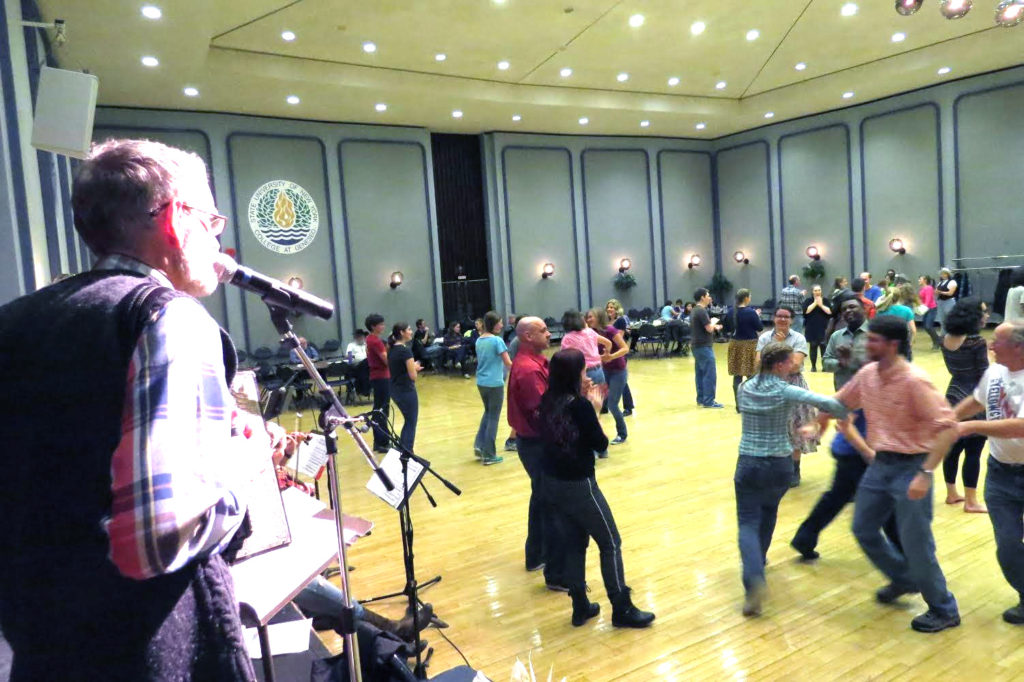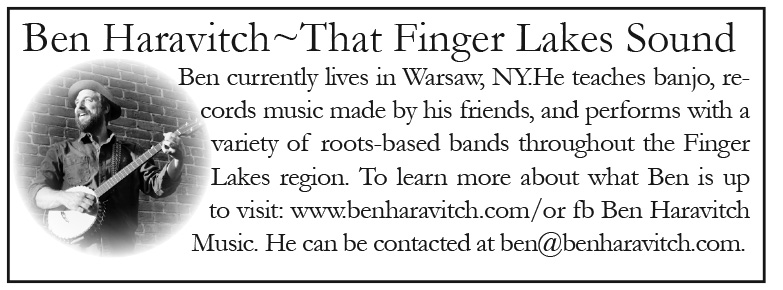That Finger Lakes Sound – Grab Yer Partner
by Ben Haravitch –
Social dancing makes for a time-tested, guaranteed good night
“Alamen left, balance to the corner; four hands round; down the center, meet your sweet, swing that girl right off her feet.”
 These are the words a writer from the Honeoye area used in 1926 to recollect the house dance parties of the “old days.” In fact, house dances took place even a century before these “old days.” Jim Kimball, a lecturer in the music department at SUNY Geneseo tells us that “we have numerous accounts or advertisements referring to social dancing all through this area as far back as the early 19th century – some refer to log cabin house party dances (back to c. 1805), others are ads for dancing masters offering classes for social dance.”
These are the words a writer from the Honeoye area used in 1926 to recollect the house dance parties of the “old days.” In fact, house dances took place even a century before these “old days.” Jim Kimball, a lecturer in the music department at SUNY Geneseo tells us that “we have numerous accounts or advertisements referring to social dancing all through this area as far back as the early 19th century – some refer to log cabin house party dances (back to c. 1805), others are ads for dancing masters offering classes for social dance.”
Kimball leads the Geneseo String Band; a student performance group that plays American and Irish folk dance music for square dances, contra dances, and concerts for students and the community. The roots of these dances trace back to the 17th and 18th centuries in England and France. Dances forming a square of eight people (one couple per side), fashionable in France as Cotillions, became what we call “square” dances. Other dances configured in lines were more popular in England and over time became what we now know as “contra’ dances. The American adaptations of these dances flaunted impromptu and sometimes complicated steps which created the need for a “caller” – someone who provides cues for the dancers to follow. Kimball points out that “calling had not been part of the English or French traditions, but by the 1820’s it was part of American country dancing and has remained so to the present.”
The main difference between square dances and contra dances is how you move throughout the dance. In a square dance, you start and end in a square formation made up of 4 sets of couples, and depending on where you are in the square, you may play a slightly different “role” in the dance. In a contra dance, you and your partner will dance for a short while with another couple through a series of interesting 4-person moves before moving down the line to the next couple with whom you’ll dance the same moves, and onward down the line. All the while your memory for the steps is being supported by the other dancers and the caller.
Another difference, says Rochester-based dance caller, Margaret Matthews, is how the dances are called. “For contra, the caller teaches the dance, prompts when the dance starts, and gradually backs out of calling to allow the dancers to groove on the music without the caller’s voice prompting. For square dance callers, the voice is part of the music. The caller uses a more rhythmic style of calling that is informed by the beat of the music.”
When Matthews isn’t calling a dance, you might see her playing bass with the band. She keeps a busy schedule playing and calling dances both here in upstate NY and in Asheville, NC where she keeps up with the current trends in Southern Old Time square dancing. As the out-dated method of learning routines to recorded music (like in elementary school gym class maybe?) is losing popularity in our area, Matthews is working on promoting the vibrant Southern dance culture with live string bands in our area. One successful dance she calls is hosted by Wild Hill Farm in Ionia, home to a barn dance series played by bands including The Crooked North, Richie and Rosie, and Mount Pleasant String Band. The events, which have included a pot luck dinner, the square dance, and an after-dance bon fire, are community-oriented and prove to be a great way to meet neighbors and promote local small businesses. Matthews reports that the last dance held at Wild Hill in November “had over eighty dancers out on the dance floor with even more on-lookers enjoying the music and watching the dancers.”
The scene is reminiscent of the stories from old-timers which Jim Kimball has preserved throughout his career. This excerpt from his article “Country Dancing in Central and Western New York State” paints a vivid picture of winter-time dances near Syracuse in the late 19th century:
Winter time can be lonely. Even if you’re not alone, it can be a very isolating time. It’s important to know that our ancestors, our neighbors in time, they understood the winter blues. They knew that getting out and interacting with other folks was an essential part of our existence. Luckily, the local tradition of social dancing to live string band music is still very much alive. We may not take a sleigh ride through the woods anymore, but opportunities still abound.
On Saturday, February 2, The Geneseo String Band, led by Professor Kimball, will host one of their two annual square dances. Always open to the public and offering enough basic instruction for anyone to join, Kimball finds that “students of all ages (both college and middle or high school) who come to our dances, as well as the students who play in the string band have lots of fun and say they want to come back.”
While all the dancing described here requires a “partner”, by no means must you come to a dance with a partner. It’s common for partners to switch up often and to sit out when you feel like it. Following this article is a list of local square and contra dance opportunities. Aside from these public dances, there are opportunities for social dancing anywhere you can fit some people, including your backyard! Contact the Owl if you’d like information about local dance callers and bands.
Social dancing offers its participants many benefits. Besides the deep connection to music and our local history, it offers an escape from our everyday interactions and our increasingly isolated virtual existence. As a long-time dance enthusiast, Margaret Matthews sums up the benefits of participating in a social dance: “I truly love how music and dance bring people together. It is one of the rare places where folks of all sorts of cultural traditions, political beliefs, religious beliefs, gender orientations and so on, find neutral ground. I’ve met people whose world is very different than mine, whose paths I would not normally cross in daily life.”
Local Social Dance Opportunities in February
~ Geneseo String Band, Feb 2
~ Country Dancers of Rochester, Thursdays
~ Flurry Festival, Saratoga Springs, Feb 15-17
~ Mount Pleasant String Band at 3HB, March 23
